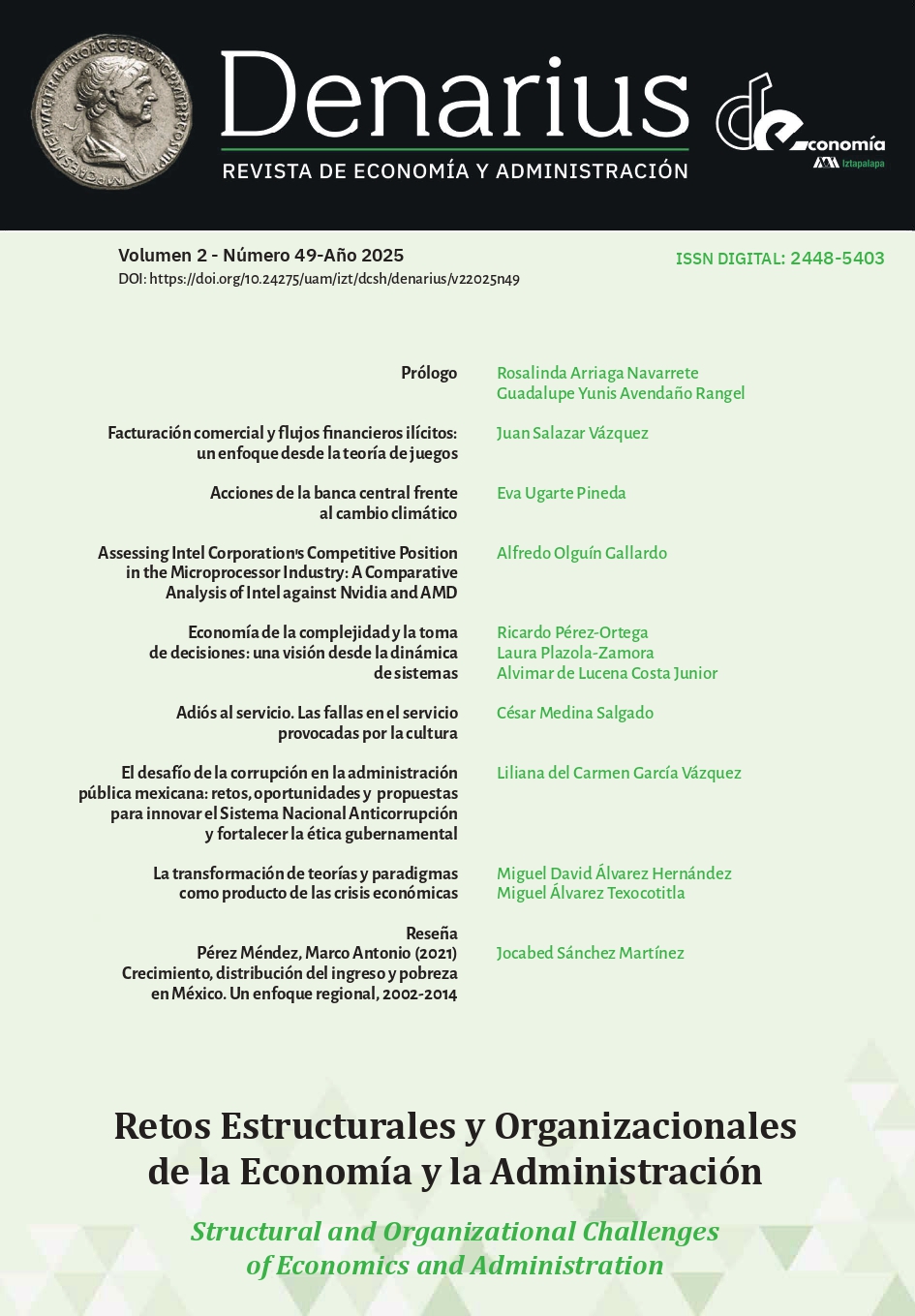Acciones de la banca central frente al cambio climático
Resumen
El cambio climático representa una amenaza creciente para la estabilidad financiera y económica a nivel global. Este trabajo es una revisión de la literatura sobre las estrategias y medidas adoptadas por los bancos centrales para mitigar los riesgos financieros derivados del cambio climático y facilitar la transición hacia una economía sostenible. La revisión de la literatura muestra que los bancos centrales están integrando progresivamente los riesgos ambientales en sus marcos de supervisión financiera, aplicando pruebas de estrés climático e implementando estrategias orientadas a fomentar el flujo de crédito hacia sectores sostenibles. Aunque existe un debate con relación a la neutralidad de los bancos centrales.
Descargas
Citas
Acharya, V., Berner, R., Engle, R., Jung, H., Stroebel, J., Zeng, X. y Zhao, Y. (2023).
Climate Stress Testing. Annual Review of Financial Economics, 15, 291-326.
Bindseil, U. y Fotia, A. (2021). Introduction to Central Banking. Springer.
Bolton, P., Despres, M., Pereira da Silva, L., Samama, F. y Svartzman, R. (2020). The
Green Swan: Central Banking and Financial Stability in the age of Climate Change.
<https://www.bis.org/publ/othp31.pdf>.
Boneva, L., Ferrucci, G. y Mongelli, F. P. (2022). Climate Change and Central Banks:
What Role for Monetary Policy? Journal of Financial Regulation and Compliance,
(3), 770-787.
Bos, K. y Gupta, J. (2019). Stranded Assets and Stranded Resources: Implications
for Climate Change Mitigation and Global Sustainable Development. Energy
Research & Social Science, 56, 101215.
Caldecott, B. (2017). Introduction to Special Issue: Stranded Assets and the Environment.
Journal of Sustainable Finance & Investment, 7(1), 1-13.
Campiglio, E., Dafermos, Y., Monnin, P., Ryan-Collins, J., Schotten, G. y Tanaka, M.
(2018). Climate Change Challenges for Central Banks and Financial Regulators.
Nature Climate Change, 8, 462-468.
Campiglio, E. (2016). Beyond Carbon Pricing: The Role of Banking and Monetary
Policy in Financing the Transition to a Low-Carbon Economy. Ecological economics,
, 220-230.
Carney, M. (2015). Breaking the Tragedy of the Horizon-Climate Change and Financial
Stability. <https://www.bis.org/review/r151009a.pdf>.
Comité de Supervisión Bancaria de Basilea (2013). Basilea iii : Coeficiente de cobertura
de liquidez y herramientas de seguimiento del riesgo de liquidez.
www.bis.org/publ/bcbs238_es.pdf>.
Comité de Supervisión Bancaria de Basilea (2014). Basilea iii : Coeficiente de Financiación
Estable Neta. <https://www.bis.org/bcbs/publ/d295_es.pdf>.
Cullen, J. (2023). Central Banks and Climate Change: Mission Impossible? Journal
of Financial Regulation, 9(2), 174-209.
D’Orazio, P. y Popoyan, L. (2019). Fostering Green Investments and Tackling Climate-
Related Financial Risks: Which Role for Macroprudential Policies? Ecological
Economics, 160, 25-37.
Diggle, P. y Bartholomew, L. (2021). Climate Change and Central Banks: The Case for
Violating Neutrality. <https://cepr.org/voxeu/columns/climate-change-and-central-
banks-case-violating-neutrality>.
Dikau, S. y Volz, U. (2021). Central Bank Mandates, Sustainability Objectives and
the Promotion of Green Finance. Ecological Economics, 184, 107022.
Dafermos, Y. (2021). Central Banking has Entered a New Era-the era of the Climate Crisis.
<https://www.soas.ac.uk/about/blog/how-should-central-banks-respondclimate-
crisis>.
Dafermos, Y., Nikolaidi, M. y Galanis, G. (2018). Climate Change, Financial Stability
and Monetary Policy. Ecological Economics, 152, 219-234.
Dafermos, Y., Gabor, D., Nikolaidi, M., Pawloff, A. y van Lerven, F. (2021). Greening
the Eurosystem Collateral Framework: How to Decarbonise the ecb’s Monetary Policy.
<https://neweconomics.org/2021/03/greening-the-eurosystem-collateral-framework>.
European Central Bank (2023). What are Haircuts.
<https://www.ecb.europa.eu/ecb-and-you/explainers/tell-me-more/html/
haircuts.en.html>.
European Central Bank (2025). ecb Adds Indicator of Nature Loss in Climate-Related
Financial Disclosures as Portfolio Emissions Continue to Decline. <https://www.
ecb.europa.eu/press/pr/date/2025/html/ecb.pr250612~484d529368.en.html>.
Fankhauser, S. y Tol, R. (2005). On Climate Change and Economic Growth. Resource
and Energy Economics, 27(1), 1-17.
Fawley, B. y Neely, C. (2013). Four Stories of Quantitative Easing. Federal Reserve Bank
of St. Louis Review, 95(1), 51-88.
Federal Reserve Board (2025). Federal Reserve Board Announces it has Withdrawn
from the Network of Central Banks and Supervisors for Greening the Financial
System (ngfs). <https://www.federalreserve.gov/newsevents/pressreleases/
bcreg20250117a.htm>.
Ferrari, R. (2015). Writing Narrative Style Literature Reviews. Medical Writing, 24(4),
-235.
Financial Stability Board (2025). fsb Roadmap for Addressing Financial Risks from
Climate Change. <https://www.fsb.org/uploads/P140725-2.pdf>.
Gasparini, M., Ives, M. C, Carr, B., Fry, S. y Beinhocker, E. (2024). Model-based Financial
Regulations Impair the Transition to Net-Zero Carbon Emissions. Nature Climate
Change, 14, 476-481.
Ghadge, A., Wurtmann, H. y Seuring, S. (2020). Managing Climate Change Risks
in Global Supply Chains: A Review and Research Agenda. International Journal
of Production Research, 58(1), 44-64.
Jesson, J., Matheson, L. y Lacey, F. M. (2011). Doing your Literature Review: Traditional
and Systematic Techniques. Sage.
Joyce, M., Miles, D., Scott, A. y Vayanos, D. (2012). Quantitative Easing and Unconventional
Monetary Policy-an Introduction. The Economic Journal, 122(564), F271-F288.
Kousky, C. (2019). The Role of Natural Disaster Insurance in Recovery and Risk
Reduction. Annual Review of Resource Economics, 11, 399-418.
Martínez, J. y Roca, J. (2000). Economía ecológica y política ambiental. Fondo de Cultura
Económica.
Marsico, B. J. (2022). Green Haircuts: Federal Risk Collateral Framework Policies
that Incorporate Climate Risk. North Carolina Banking Institute, 26(1), 137-163.
Macaire, C. y Naef, A. (2021). Greening Monetary Policy: Evidence from the People’s
Bank of China. International Conference on «Statistics for Sustainable Finance.
<https://www.bis.org/ifc/publ/ifcb56_08.pdf>.
Mersch, Y. (2018). Climate Change and Central Banking. Workshop Discussion:
Sustainability is Becoming Mainstream. <https://www.ecb.europa.eu/press/
key/date/2018/html/ecb.sp181127.en.html>.
Narbel, P. A. (2013). The likely Impact of Basel III on a Bank’s Appetite for Renewable
Energy Financing. Norwegian School of Economics-Working Papers.
Network for Greening the Financial System, ngfs (2020). Guide to Climate Scenario
Analysis for Central Banks and Supervisors. <https://www.ngfs.net/sites/default/
files/medias/documents/ngfs_guide_scenario_analysis_final.pdf>.
Network for Greening the Financial System, ngfs (2025). ngfs Climate Scenarios for
Central Banks and Supervisors-Phase V. <https://www.ngfs.net/en/publications-
and-statistics/publications/ngfs-climate-scenarios-central-banks-and-supervisors-
phase-v>.
Nordhaus, W. (2019). Climate Change: The Ultimate Challenge for Economics.
American Economic Review, 109(6), 1991-2014.
Pal, I., Kumar, A. y Mukhopadhyay, A. (2023). Risks to Coastal Critical Infrastructure
from Climate Change. Annual Review of Environment and Resources, 48, 681-712.
Prudential Regulation Authority (2015). The Impact of Climate Change on the
uk Insurance Sector. <https://www.bankofengland.co.uk/-/media/boe/files/
prudential-regulation/publication/impact-of-climate-change-on-the-uk-insurance-
sector.pdf>.
Rozenberg, J., Hallegatte, S., Perrissin-Fabert, B. y Hourcade, J. C. (2013). Funding
Low-Carbon Investments in the Absence of a Carbon Tax. Climate Policy, 13(1),
-141.
Setzer, J., Higham, C., Jackson, A. y Solana, J. (2021). Climate Change Litigation and
Central Banks. ecb Legal Working Paper Series No. 21.
Schnabel, I. (2021). El cambio climático y la política monetaria. Finanzas y Desarrollo,
(3), 53-55.
Semieniuk, G., Campiglio, E., Mercure, J.-F., Volz, U. y Edwards, N. R. (20219. Low-Carbon
Transition Risks for Finance. WIREs Climate Change, 12(1), e678.
Steele, G. (2025). The Fed says it’s Independent, but Leaving the ngfs was Political. Green
Central Banking. <https://greencentralbanking.com/2025/03/18/fed-says-its-independent-
but-leaving-the-ngfs-was-political>.
tcfd Task Force on Climate-related Financial Disclosures (2017). Recommendations
of the Task Force on Climate-Related Financial Disclosures. <https://assets.
bbhub.io/company/sites/60/2021/10/FINAL-2017-TCFD-Report.pdf>.
The Bank of England (2022). Results of the 2021 Climate Biennial Exploratory
Scenario (cbes). <https://www.bankofengland.co.uk/-/media/boe/files/stress-testing/
/results-of-the-2021-cbes.pdf>.
The Bank of England (2025). The Bank of England’s Climate-Related Financial
Disclosure 2025. <https://www.bankofengland.co.uk/climate-change/
the-bank-of-englands-climate-related-financial-disclosure-2025>.
unep Finance Initiative (2019). Changing Course: A Comprehensive Investor Guide to
Scenario-Based Methods for Climate Risk Assessment, in Response to the tcfd.
<https://www.unepfi.org/wordpress/wp-content/uploads/2019/05/TCFD-Changing-
Course-Oct-19.pdf>.
United Nations Environment Programme, unep (2024). A Comprehensive Review of Global
Supervisory Climate Stress Tests. <https://www.unepfi.org/themes/climate-change/
a-comprehensive-review-of-global-supervisory-climate-stress-tests/>.
Weidmann, J. (2019). Climate Change and Central Banks. <https://www.bis.org/
review/r191029a.htm>.
Derechos de autor 2025 Denarius

Esta obra está bajo licencia internacional Creative Commons Reconocimiento-NoComercial-CompartirIgual 4.0.














